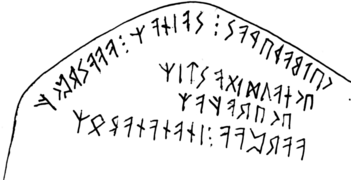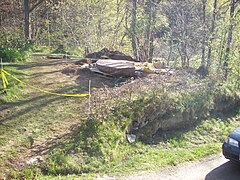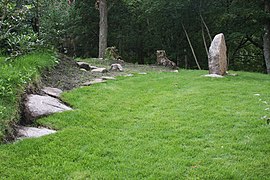Runestone from Hogganvik
The Hogganvik runestone is a west of in 2009 on the farm Hogganvik Mandal in Kristiansand in Fylke Agder in Norway discovered Runestone . With 61 runes it contains one of the longest inscriptions in the older Futhark . The stone is dated approximately between 350 and 500 AD. With 61 runic characters, it is one of the longest known inscriptions from this period. It is the first runestone found in Norway since 1947. Under the rune stone lies another large stone, which experts believe to be the capstone of a grave. Since another grave was discovered on the same property about 20 years ago, this interpretation is likely.
description
The stone is 145 cm high, 152 cm wide and 23-25 cm thick and is said to weigh 500 to 800 kg. The stone lay flat and is in good condition. It is only slightly weathered and the runes are clearly visible. This could indicate that the stone did not stand for long.
- Hogganvik stones
inscription
The oldest rune series that has survived consists of 24 characters. At first it was only used by the North Germanic people, during the migration period it was also used occasionally by the East and West Germans (from the 5th century). Only about 350 inscriptions in this oldest rune series have been discovered so far. The inscription consists of four right-hand (read from right to left) lines, which cannot all be interpreted in a meaningful way. One line begins with Ek Naudigastir ("I Naudagistr"). It is believed that Naugadistr is a man's name.
- A: [?] Kelbaþewas: s (t) ͡ainaR: aaasrpkf
- B: aarpaa: inanana (l / b / w) oR
- C: eknaudigastiR
- D: ekerafaR
A preliminary report by runologist James E. Knirk provides the following information regarding the content:
- A: contains the dedication of the tombstone: “Stone of [S] kelba-þewaR”.
- A + B: make little sense linguistically and could contain an encrypted message or a rune-magic sequence: aaasrpkf / aarpaa .
- B (remainder): is difficult to interpret. The line could contain a preposition “within, in” as well as a noun that cannot be determined with certainty (“Nadel” ?, “Radnabe”? “Corner of a hut”?).
- C + D: (between lines A and B) represent the signature of the rune scratcher: "I, NaudigastiR [=" emergency guest "] / I, [called] the wolverine".
literature
- James E. Knirk: Runestones med eldre runer from Hogganvik ved Mandal. In: Nicolay 111 (2010), pp. 13-18.
- Michael Schulte: The linguistic interpretation of the Hogganvik inscription. Additions to the preliminary report. In: Guus Kronen u. a. (Ed.), Thi Timit Lof. Festschrift for Arend Quak on his 65th birthday (= Amsterdam contributions to older German studies, 67), Rodopi, Amsterdam 2011, pp. 57–68.
- Michael Schulte: The Norwegian Hogganvik Stone as an Emblem of Social Status and Identity . In: Journal of the North Atlantic Special vol. 4, 2013, pp. 120–128 ( full text ).
Web links
- Photograph of the stone from Hogganvik with colored rune marks (JPG)
- Information on the excavation at the site from the archaeologist Frans-Arne Stylegar (English)
- Further images by Frans-Arne Stylegar
Individual evidence
- ↑ a b Knirk, James E. Runic inscription from Hogganvik, Mandal, Vest-Agder ( Memento of the original from June 4, 2011 in the Internet Archive ) Info: The archive link was automatically inserted and not yet checked. Please check the original and archive link according to the instructions and then remove this notice. (PDF, 2009) (preliminary report), October 27, 2009.
Coordinates: 58 ° 2 '15.2 " N , 7 ° 21' 53.9" E




